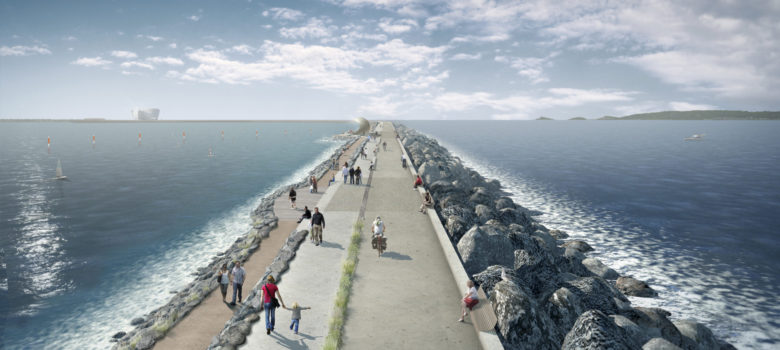
Following last week’s feature on kite power, we are now focusing on tidal lagoon power, a technology also expected to make an impact in the next few days. We’ve written about Swansea Tidal Lagoon before, but until now it has seemed speculative. It’s been a long planning process, drawn out by delays in approval and funding. But now the project has finally been given the green light, and will start extensive building next year.
Swansea Tidal Lagoon is an exciting development, because it could be a huge, reliable source of green energy – and also a world first! The lagoon is expected to produce 320MW, enough to power 155,000 homes each year. Aside from increasing renewable energy generation in the UK, and helping to ease increasing pressure on the National Grid, and it could also be a great economic export. There are already plans for a much larger 2.7GW lagoon in Cardiff once this ‘pathfinder project’ has paved the way. You can see a 3D model here.
As far as the environmental impact goes, extensive tests were conducted before the project being given the final go-ahead. While the people in charge are keen to stress that damage to ecosystems will be limited, it is difficult to predict exactly in advance. It is clear, though, that the company are taking this seriously; they are employing marine biology experts to plan how best to limit disturbance to fish and cultivate new species in controlled conditions. The bottom line is that no large infrastructure project, and no form of renewable energy generation, will be entirely without consequences for the environment – however good the intentions. But green energies are infinitely preferable to those which produce huge carbon emissions. A recent independent review said that ‘it is hard to find an energy source where people are more instinctively supportive than tidal power.’
We spoke to Ioan Jenkins, Development Director for Tidal Lagoon Swansea Bay Plc, about the current status of the project and what it hopes to achieve.
There has been a lot written about the tidal lagoon in the news and building progress has been stunted for a while for various reasons – what stage are you at now?
The publication of the Government’s Independent Review by Charles Hendry has set the final piece of the jigsaw in place. We are now continuing discussions with Government and look forward to working with ministers and officials to bring this new industry to life.
Have you got a date for when you expect the tidal lagoon to be operational?
We hope to start on site in Spring 2018 which means that we will power on in 2022.
What problems have you encountered in the planning and approval stages?
We have been very fortunate to have the support and backing of the local community, industry and politics. The Development Consent Order was granted in June 2015 following a very detailed examination process.
What is special about Swansea as a location?
Swansea Bay has a fantastic tidal range with an average tide of 9m.
Will the lagoon produce constant levels of power at all times, or does it change with the tide?
No, the lagoon will not produce constant energy output at all times. Over a 24-hour period, it will produce energy as four distinct pulses, with each pulse lasting about 3.5 hours and each pulse separated from the next one by about 2.5 hours. So energy output is intermittent, but also totally predictable. Output also depends on the stage of the tide; spring tides give higher levels of overall energy output than neap tides. But there will always still be these 4 pulses during the day.
Is this a pilot for potential bigger projects going forward?
Yes, we hope to deliver a fleet of six lagoons in UK waters that will generate around 10% of the UK’s power requirements.
Will it be coupled with an energy storage solution?
At the moment there is no proposal to couple Swansea Bay tidal lagoon with an energy storage solution. But it is always possible to add energy storage at a later stage.
How far ahead can you predict tide times?
Forever…
Are there any downsides for the environment?
We believe that the project will have a net benefit for the environment. There are detailed reports on environmental considerations online here.
Why is the tidal lagoon expected to be a reliable energy source?
Tidal lagoons provide entirely predictable, near base load power for 120 years.
Your thoughts
Do you think TLP could be a productive renewable energy source? Leave us a comment below!












Although one tidal lagoon cannot produce constant or continuous power, a fleet of lagoons around the coast, because of the predictability of the tides, can provide a continuous input into the national grid. The capital cost is considerable but ,has been paid off, the electricity generated is very cheap/